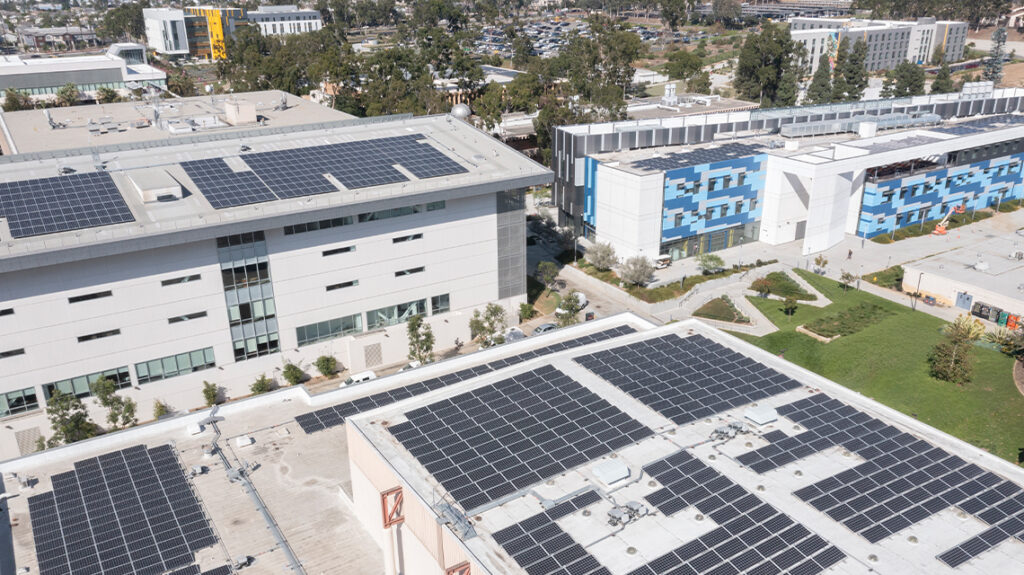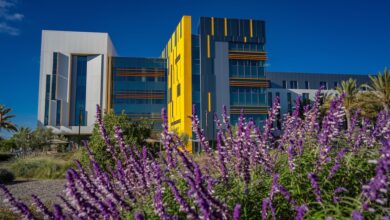
Within the past year, five of CSUDH’s largest buildings have gone from merely consuming energy to generating it.
Approximately 2,400 solar panels now adorn the rooftops of the Torodome gymnasium, the Science and Innovation building, the Leo F. Cain Library, the Social and Behavioral Sciences building, and Welch Hall.
The installations, which were completed between December 2021 and February 2022, officially came online in June as part of a broader campaign by Facilities Services and the Office of Sustainability to find more ways to increase renewable energy resources on campus to further reduce the university’s considerable carbon footprint.
Central Plant Manager Kenneth Seeton said the arrays will significantly reduce CSUDH’s dependence on the outside power grid and should generate nearly 2 million kilowatt hours of electricity each year, which represents a savings of nearly $200,000 annually. What’s more, CSUDH paid almost nothing in upfront costs.
“We have a power purchase agreement with Duke Energy for the next 20 years. They installed the panels at no cost, and they are responsible for keeping them running. In turn, we will purchase the energy they produce over that period for 50 percent less than we currently pay for non-renewable energy,” Seeton said.
The new solar installations represent a critical step forward to ensuring that campus buildings are carbon neutral, said Ellie Perry, manager of CSUDH’s Office of Sustainability.
“Our broader sustainability goals are tied to becoming a net zero energy campus where our buildings run off renewable energy entirely without drawing from the outside grid,” Perry said.
She added that two other locations on campus – the Urban Farm shed and the Net Zero Center – have much smaller solar installations to allow those structures to operate at a net zero capacity, but that CSUDH hasn’t had any significant renewable technology deployed since the panels in Parking Lot 1, which went offline in 2016.
Renewable energy is also a central feature of the Office of Sustainability’s Climate Action Plan, approved in August 2022 by President Thomas A. Parham and his cabinet. The plan documents the university’s progress and continued efforts to reach carbon neutrality by 2045.
Parham and CSUDH’s senior leadership highlighted the importance of a broad and comprehensive approach to sustainability in the university’s new Strategic Plan by including it among the university’s core values.
“We recognize and live up to our responsibility to our campus community, and the community at large, through the sustainable and equitable stewardship of our natural, social, and economic resources,” the plan states.
Deborah Wallace, vice president of administration and finance, has worked closely with Seeton and Perry to prioritize new approaches to sustainability within the cabinet. She said the new solar installations are another example of how CSUDH finds creative solutions to advance local sustainability efforts that have a global impact.
“The solar project is a 20-year investment in our future that will enable the campus to create renewable energy far beyond the purchase agreement itself,” Wallace said.
Seeton said the next two years will bring even more opportunities to increase renewable energy sources on campus. “We’re in the middle of a complete electrification rebuild that will include all the hardware necessary for SCE to extend rooftop solar to more buildings on campus.”
In the meantime, Facilities Services in partnership with the Office of Sustainability continues to increase efficiency wherever and however they can with a mix of renewable energy technology, sensor-based smart lighting systems, and educational campaigns to raise awareness about how even small actions can make a big difference.
“The campus now uses less energy than it did in 2017, and we’ve added 300,000 square feet of new building space since that time,” Seeton said.









